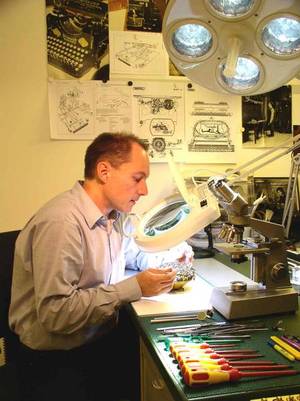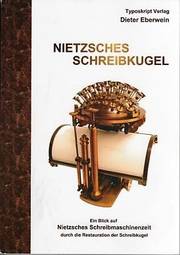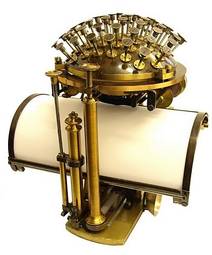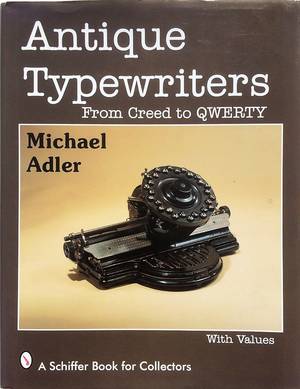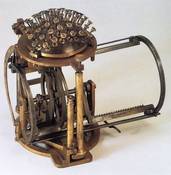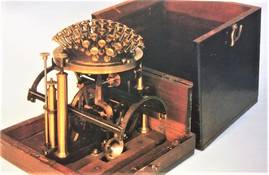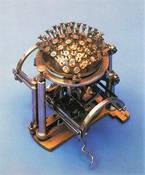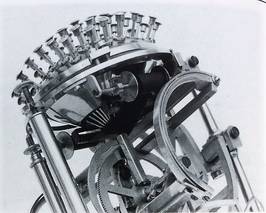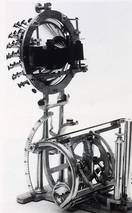The Malling-Hansen Writing Ball: Assessing its Quality.
Research and comments by Jørgen Malling Christensen.
When talking to people who are not cognoscenti about antique typewriters, extolling the virtue and immensely high quality of the Malling-Hansen writing balls, it naturally happens that the listeners believe I am biased – biased because of my long-term membership of the International Rasmus Malling-Hansen Society, and also because he was a brother of my great-grandfather, so ancestral pride may be attributed to my views. The skepticism is understandable. Hence, it is meaningful and probably more convincing if I quote other people’s assessments of the writing ball quality, and the present article has this very purpose. So let me call some other witnesses to the stand!
Dieter Eberwein.
Dieter is one of the founding members of our Society in May 2006. He is also, without any doubt, the leading expert in terms of technical aspects of the writing ball, having painstakingly and reverently restored several writing balls. Dieter documented the most famous restoration in his publication: “Nietzshes Screibkugel”[1]. By trade Dieter Eberwein is a precision instrument maker, and his views are based upon many years of practical, professional experience in that field. He is also a long-time researcher into the history of the typewriter. Therefore, it is with a solid background – in practice and theory – when Dieter states the following:
“Die beispielslose optische Gestaltung sowie die technische Praezision der Malling-Hansen-Schreibkugel blieben in der gesamten Schreibmaschinengeschichte unerreicht. Es wurde bis heute bereits mehrfach versucht, Nachbauten dieser Schreibmaschine herzustellen, doch selbst mit modernster Technik ist das handwerkliche Geschick der alten Meister nicht zu ersetzen. Keiner der Nachbauten funktioniert so wie das Original.” (“Nietzshes Screibkugel”, p. 24).
In my translation:
“The unrivalled visual design as well as the technical precision of the Malling-Hansen writing ball remain unequalled in the entire typewriter history. There have, until this day, been several attempts to produce copies of this typewriter, yet even the most advanced and modern technique has not been able to replace the level of workmanship and skill of the old master. None of the reproductions work like the original”.
The first sentence in the above quotation carries a lot of weight; it must be remembered that Dieter Eberwein is, naturally, well acquainted with all the other famous and important names/machines in the early history of typewriter development, such as: Scholes & Glidden; Hall; Mignon; Blickensderfer; Hammond; Yost; Williams; Remington; Caligraph; Crandall; Columbia; Underwood; North; Franklin; Horton; Noiseless; Salter; Empire; Bar-Lock; Imperial; Densmore; Smith Premier; Royal; Woodstock; Continental; Alissoff; Wellington; - just to mention a few of the 19th century important typewriter invention names.
In addition to the unrivalled technical precision of the writing balls (particularly the models developed between 1875 and 1888), Dieter Eberwein also calls our attention to another unique feature: the design of the keyboard. From diary sources[2] we know that Malling-Hansen worked between 1865 until at least 1870 to develop the most efficient placement of the letters and other signs. According to Eberwein, Malling-Hansen developed an ergonomically sound placement of the letters, making sure that the letters most frequently used were placed in such a way that the fingers able to strike more rapidly than the others – index, middle and ring fingers – were set close to such digits.
This is consonant with the fact that Malling-Hansen’s primary ambition was to construct machines able to type as speedily as possible for normal users; he envisioned these machines to be able to follow the speed of a speaker in parliament, in court rooms and in offices
SA: It should also be noted that RMH, in cooperation with professor C. P. Jürgensen, constructed an even faster machine aiming at providing an alternative to stenography: this was the Takygraph with an amazing typing speed. RMH was of the opinion that a normal writing ball could be operated with a speed matching human speech, but perhaps he was being somewhat optimistic on behalf of his invention? Even if RMH was the inventor of the writing ball, we must also give credit to C.P.Jürgensen for his very solid craftsmanship and his refined precision-work in the production of the writing balls.
Because of the global success of the Remington typewriters, the world unfortunately ended up with the QWERTY-keyboard on typewriters and subsequently on computer keyboards, but the Malling-Hansen keyboard would have enabled users in most countries to type faster and more accurately, because it was more logical and more ergonomic. This would also have been true for users in languages such as English, French and German, because Dieter Eberwein has convincingly proved that the statistical relative frequency of the letters in those languages would also have greatly benefited from making use of the Malling-Hansen keyboard letter distribution, rather than QWERTY. In summary, Dieter Eberwein claims that Malling-Hansen’s genius resides in three aspects of the writing ball:
1. The general design of the machine.
2. The technical precision of its parts.
3. The keyboard design.
Michael Adler on the Writing Ball.
The next witness I am calling to the stand is a world leading authority on antique typewriters, Michael Adler. MA is the author of two excellent books about typewriter history,“The Writing Machine, a history of the Typewriter” published in 1973 and “Antique Typewriters, From Creed to QWERTY” (1997).
Our website has an article about the former publication – see under “writing ball”, then: ‘Articles from recent time’ and then: ‘Michael H. Adler on the writing ball, part one’. The reader is referred to that article. However, I would like to quote one statement from Adler’s first book in the present article. Adler compares the writing ball of the 1876 version – at the time of the Philadelphia Exhibition – with the typewriter of that period produced by Sholes, Densmore and Yost and states as follows: “…the Writing Ball was a better typewriter than the one they were offering at that time. It printed better and more quickly and its service record was impeccable. In fact, the Writing Ball may be considered the most nearly perfect piece of precision engineering in typewriter history, past or present. This fact can hardly be appreciated from photographs, but is readily apparent on direct examination.” (p. 157, my italics).
SA: It is worth noting that the writing ball was awarded with a gold medal at the Centennial Exhibition in Philadelphia in 1876, while “The Typerwriter” was virtually ignored.
In the 1997 publication, Adler has the following to say about the writing ball (he is now using the Danish name: ‘skrivekugle’):
“Two machines dominated the beginning of the third generation…and it is difficult to imagine two more different products. One was European, the other American. The first was a spectacular piece of mechanical engineering which ultimately failed, the other started out as a woefully inadequate piece of mechanical equipment which ultimately proved a spectacular success. They were almost exact contemporaries, with the Danish contender possibly the earlier of the two by a slight margin. They certainly knew nothing of each other – not until much later – and yet they were both engaged in struggles of invention and production at the same time.
The Dane was a director of the Deaf and Dump Institute in Copenhagen by the name of Hans Johan Rasmus Malling Hansen, whose first tentative model was from the year 1865. The design was of radial type plunger inspiration first recorded by the Italian Celestino Galli[3] as far back as 1830 and subsequently selected by the likes of Foucauld[4] and others. More recently, another Dane called Peters[5] was simultaneously working on a comparable type plunger device in about 1864, but the patent protecting the invention was not filed until some six years later, by which time Malling Hansen was already in production.
Who borrowed what ideas from whom was at one time hotly disputed but is largely academic, for it was Malling Hansen who developed the principal into his famous Skrivekugle which must surely rank among the most desirable if not necessarily the rarest typewriters in the world.
The Skrivekugle…..was considerably modified in the course of its manufacture but certain elements remain constant. One of these is the essential design of the sphere, from which type plungers protrude in apparent confusion but in reality are in regular rows. These type plungers stick out like the quills of a porcupine, with a small button at the end on which the letters are engraved. The plunger in the centre of the sphere is vertical and as they spread further from the centre the plungers become progressively more angled so that they radiate perfectly from the central printing point. The whole assembly is precision engineered, and quite beautiful to behold.”(p.53; my italics).
On pages 185-186 Adler comments that the “Skrivekugle” is “…one of the rarest and most desirable machines which collectors all over the world dream about but few possess”. …..”It was a wonderful machine, infinitely superior to the rival Sholes and Glidden, and it was sold in quite some numbers throughout the world , winning prizes and awards and rave reviews wherever it went. As late as 1886, the open-frame model current at the time ‘appears to be the only foreign competitor American type writers have’ and while that was not strictly accurate, of course, it indicates nevertheless the respect with which the Writing Ball was treated.”[6]
Adler’s final statement (p.186): “The Hansen Writing Ball is a machine to die for, and the price one might reasonably expect to pay is commensurate with its desirability.”
When we see the wonderful illustrations of the writing ball in Adler’s publication, we are certainly reminded that this machine, apart from being functional and efficient, also has a very pleasing aesthetical design, particularly the models from 1875 and onwards. The writing ball is one of the wonders of the 19th century and has a proud place as a Danish icon.
This was reaffirmed when in April 2017 Design Museum Denmark made an agreement with one of our founding members, Lars Mathiesen, about receiving the donation of a mini writing ball (half size). This very special and rare writing ball will be part of the museum collection and exhibitions of icons of the early industrial age.
The raison d’etre of Design Museum Denmark is to be an archive, a research centre and an exhibition centre, showing the best of Danish and international design. Since its foundation in 1890 this museum has been in the forefront with the purpose of inspiring the continued development of Danish design in arts, craft and industry. Now, it is a curious and interesting fact that Lars Mathiesen, a great-grandchild of Rasmus Malling-Hansen, is also an industrial designer, and some of his designs have also been included in the collection of design Museum Denmark.
[1] JMC: First edition 2005, Typoskript-Verlag, Schauenburg (there is also a second, revised and extended edition, year of publication not known to me), ISBN-10: 3-00-015554-6 and ISBN-13: 978-3-00-015554-6.
[2] JMC: The diary of Johan Alfred Heiberg, 1848-1936, minister, younger brother of Malling-Hansen’s first wife, Cathrine Georgia Heiberg. Johan A. Heiberg was personally present several times, seeing Malling-Hansen testing various placements of the letters on a porcelain hemisphere already in 1865. Two such hemispheres are still in existence.
[3] JMC: Celestino Gallo, 1803-1868, Italian philosopher, author and linguist. He designed his machine around 1830 and called it ‘potenografo’ or ‘clavicembalo scrivano’. However, it is not clear whether the invention remained on the drawing board or whether he actually built the machine (source: Italian Wikipedia).
[4] JMC: Pierre Foucauld (also spelt Foucault and Foucaux) was blind; he invented a typewriter which he called ‘Raphigraphe’ in 1839 and made two more versions of it, gradually improving the design for the use of blind people. His final model was called ‘Clavier Imprimeur’ (1849), exhibited in London in 1851, earning Foucauld a gold medal and manufactured on a small scale (Source: Michael Adler).
[5] JMC: Jacob Ahrend Peters, 1835-1924, a Danish teacher, constructed a machine sometimes in the 1860s, and in 1924-25 a controversy emerged, when professor Hannover claimed that Peters was the initial inventor of the principle behind the writing ball, and alleged that Malling-Hansen had copied Peters’ design. This was decisively refuted by two of Malling-Hansen’s daughters – Engelke Wiberg and Johanne Agerskog - in a booklet published in 1925 and in their public discussion in newspapers. For further details, see our article ‘the controversy in 1924/25’.
[6] MA: Inland Printer 1886

